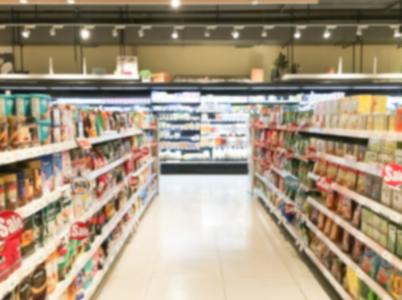Find out how this sneaky supermarket strategy is trying to influence you to buy brands!
By
- Replies 40
Are you a savvy shopper or do you fall prey to the shiny displays and sale tags at your local supermarket?
If you're like most people, you probably have a shopping list in hand, but the moment you spot a sale, you're drawn in like a moth to a flame.
But did you know that your shopping choices are being subtly influenced by a clever strategy used by brands and supermarkets?
It's called the 'buy level' strategy, and it could be costing you more than you realise.
Ever wondered why your favourite brands always seem to be at eye level on the supermarket shelves?
It's not a coincidence. Brands pay a premium, known as 'slotting fees', to have their products placed at eye level, increasing the likelihood of them being chosen over other brands.
Peter Resanceff, a Consumer Psychologist, Behaviouralist and Brand Strategist, explains that when it comes to supermarkets, it's all about 'location, location, location’.
‘The old adage...is as relevant in the supermarket as it is in real estate,’ Resanceff said.
'Many shoppers are totally unaware that the top spots on supermarket shelves are fiercely fought over by the major brands.’
‘The best positions on the shelf come at a price, and many of the big brands are willing to pay retailers handsomely for these premium spots.'
According to Resanceff, the mantra in marketing is 'eye level is buy level', with research consistently showing that products positioned at eye level sell more.
'It's where people's eyeballs naturally gravitate to when they approach a supermarket shelf,' he explained.
'So, it's no surprise that Woolies, Coles or other retailers will prioritise more expensive products, or those products that offer them higher profit margins, in this prime “eye level” position on the shelf.'
The 'slotting fees' also dictate the placement of sales stands you see at the front of aisles. This strategy isn't limited to physical stores; it's prevalent online too.
‘This tendency for retailers to push products and brands with higher prices and profit margins also happens frequently online,’ Resanceff remarked.
'Next time you search for a product on a retailer's website, take note of the first page of search results.’
‘The products that appear on the first screen will typically be those that offer the retailer the highest profit margins.’
‘Again, the big brands pay big bucks to be featured on this first screen,' Resanceff added.
So, how can you counter this natural tendency to shop at eye level and save money on your grocery bills? The secret lies in looking beyond the eye level.
'Next time you're at the supermarket, make sure you take a moment to look above and below to see what else is on offer,' Resanceff suggested.
'Likewise, if you're online, take the time to click through to the next few screens of search results. You may find that you leave with a much better value shopping trolley and extra dollars in your wallet.'
Another effective strategy to save money is to practise comparison shopping.
Instead of grabbing the first item you see, take a moment to compare different brands and their prices per unit.
This can help you identify the best value for money.
Remember, the cheapest product isn't always the best value, especially when it comes to groceries. Consider the quality, quantity, and the price per unit before making a decision.
Having a shopping list and sticking to it can also help you avoid falling for the 'buy level' strategy.
A list not only helps you remember what you need to buy but also keeps you focused and less likely to be swayed by shiny displays and sale tags.
Being aware of the 'buy level' strategy and knowing how to counter it can help you become a smarter shopper and save money on your grocery bills.
So, the next time you're at the supermarket or shopping online, remember to look beyond the eye level and compare different brands and their prices.

What do you think of this story? Have you noticed these supermarket strategies? Let us know in the comments below.
If you're like most people, you probably have a shopping list in hand, but the moment you spot a sale, you're drawn in like a moth to a flame.
But did you know that your shopping choices are being subtly influenced by a clever strategy used by brands and supermarkets?
It's called the 'buy level' strategy, and it could be costing you more than you realise.
Ever wondered why your favourite brands always seem to be at eye level on the supermarket shelves?
It's not a coincidence. Brands pay a premium, known as 'slotting fees', to have their products placed at eye level, increasing the likelihood of them being chosen over other brands.
Peter Resanceff, a Consumer Psychologist, Behaviouralist and Brand Strategist, explains that when it comes to supermarkets, it's all about 'location, location, location’.
‘The old adage...is as relevant in the supermarket as it is in real estate,’ Resanceff said.
'Many shoppers are totally unaware that the top spots on supermarket shelves are fiercely fought over by the major brands.’
‘The best positions on the shelf come at a price, and many of the big brands are willing to pay retailers handsomely for these premium spots.'
According to Resanceff, the mantra in marketing is 'eye level is buy level', with research consistently showing that products positioned at eye level sell more.
'It's where people's eyeballs naturally gravitate to when they approach a supermarket shelf,' he explained.
'So, it's no surprise that Woolies, Coles or other retailers will prioritise more expensive products, or those products that offer them higher profit margins, in this prime “eye level” position on the shelf.'
The 'slotting fees' also dictate the placement of sales stands you see at the front of aisles. This strategy isn't limited to physical stores; it's prevalent online too.
‘This tendency for retailers to push products and brands with higher prices and profit margins also happens frequently online,’ Resanceff remarked.
'Next time you search for a product on a retailer's website, take note of the first page of search results.’
‘The products that appear on the first screen will typically be those that offer the retailer the highest profit margins.’
‘Again, the big brands pay big bucks to be featured on this first screen,' Resanceff added.
So, how can you counter this natural tendency to shop at eye level and save money on your grocery bills? The secret lies in looking beyond the eye level.
'Next time you're at the supermarket, make sure you take a moment to look above and below to see what else is on offer,' Resanceff suggested.
'Likewise, if you're online, take the time to click through to the next few screens of search results. You may find that you leave with a much better value shopping trolley and extra dollars in your wallet.'
Another effective strategy to save money is to practise comparison shopping.
Instead of grabbing the first item you see, take a moment to compare different brands and their prices per unit.
This can help you identify the best value for money.
Remember, the cheapest product isn't always the best value, especially when it comes to groceries. Consider the quality, quantity, and the price per unit before making a decision.
Having a shopping list and sticking to it can also help you avoid falling for the 'buy level' strategy.
A list not only helps you remember what you need to buy but also keeps you focused and less likely to be swayed by shiny displays and sale tags.
Being aware of the 'buy level' strategy and knowing how to counter it can help you become a smarter shopper and save money on your grocery bills.
So, the next time you're at the supermarket or shopping online, remember to look beyond the eye level and compare different brands and their prices.
Key Takeaways
- Shoppers are influenced by a supermarket strategy known as 'buy level,' where products at eye level are more likely to be selected.
- Brands and supermarkets utilise 'slotting fees' to secure premium shelf positions for their products, which can affect consumer choice and spending.
- Consumer Psychologist Peter Resanceff highlights that the best shelf locations are highly contested, with major brands willing to pay for these spots.
- To find better value during grocery shopping, consumers should look at items positioned above and below eye level and explore beyond the first page of search results when shopping online.
What do you think of this story? Have you noticed these supermarket strategies? Let us know in the comments below.








